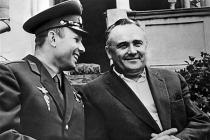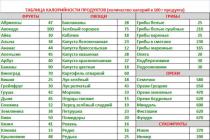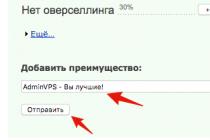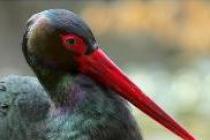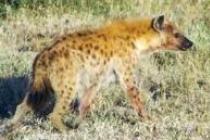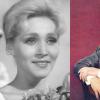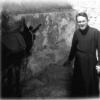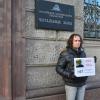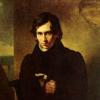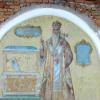Russia-USSR became the first space power! And continues to be today!
For as long as I can remember, everyone knew the names of the cosmonauts; these were the main heroes - as they would now say “superman” - of the peaceful Soviet era.
During the flights, all radio and television broadcasts were interrupted, the brilliant Levitan solemnly announced the new flight, then the newspapers printed photos of the new cosmonauts on the front pages.
Belka and Strelka also flew long before I was born, but for some reason I knew them too.
.
Space flights became a routine somewhere in the second half of the 70s.
Before interest waned, the last “spike” was Soyuz-Apollo. In Omsk, the live broadcast of the docking of the American and Soviet ships was at night, I remember it in a dream, I was woken up by my cousin (10 years older than me), he did not sleep, he really wanted to see this historical event.
Then the cosmonaut corps was replenished with new faces, there were many cosmonauts, and not everyone knew them anymore. Flights with cosmonauts from socialist countries were more “promoted”.
But everyone knew the first ones!
The first cosmonauts of the USSR
Cosmonaut No. 1 - Yuri Alekseevich Gagarin (1934 - 1968)

Yuri Gagarin (1934-1968), fighter pilot, first space flight:
April 12, 1961 "East".
Died on March 27, 1968 in a plane crash.
Gagarin's funeral
The historic flight of Yuri Alekseevich Gagarin took place on the morning of April 12, 1961.
The Vostok spacecraft launched from the Baikonur Cosmodrome and, having flown once around the Earth, landed in the Saratov region.
Moreover, Gagarin ejected and landed with a parachute.
Cosmonaut No. 2 German Stepanovich Titov (1935 - 2000)

German Stepanovich Titov (1935-2000), air defense pilot, one space flight: August 6, 1961 Vostok-2. Left the cosmonaut corps on June 17, 1970.
Later he worked at the Space Research Institute.
Cosmonaut No. 3 Andrian Grigorievich Nikolaev (1929 -2004)

Andriyan Grigorievich Nikolaev (1929-2004), air defense pilot, two space flights: August 11, 1962 Vostok-3; June 1, 1970 Soyuz-9. Left the cosmonaut corps on January 26, 1982.
Cosmonaut No. 4 Pavel Romanovich Popovich (1930 - 2009)

Pavel Romanovich Popovich (1930-2009), Air Force pilot, two space flights: August 12, 1962 Vostok-4; July 3, 1974 Soyuz-14. Left the cosmonaut corps on January 26, 1982.
Cosmonaut No. 5 - Valery Fedorovich Bykovsky (1934)

Valery Fedorovich Bykovsky (1934), Air Force pilot, three space flights: June 14, 1963 Vostok-5; September 15, 1976 Soyuz-22; August 26, 1978 Soyuz-31. Left the cosmonaut corps on January 26, 1982.
Cosmonaut No. 6 - The first female cosmonaut - Valentina Vladimirovna Tereshkova (born 1937)

Space flight June 16, 1963, Vostok-6, at the same time Vostok-5 was in orbit, piloted by pilot cosmonaut Valery Bykovsky.
Cosmonaut No. 7. Vladimir Mikhailovich Komarov

Vladimir Mikhailovich Komarov (1927-1967), Air Force pilot-engineer, two space flights: October 12, 1964 “Voskhod”;
April 23, 1967 Soyuz-1. April 24, 1967 Vladimir Komarov died during landing after a flight on the Soyuz-1 spacecraft. (Yu.A. Gagarin was appointed as his backup for this flight).
We have a book about Komarov at home.
On October 12, 1964, the world's first multi-seat spacecraft flew into space. For the first time, the crew included not only a pilot, but also an engineer and a doctor.
For the first time in history, the crew flew without spacesuits.
The soft landing system was used for the first time. The call sign “Rubin” sounded from orbit for 24 hours. The total flight duration was one day and 17 minutes, during which time the ship circled the globe 16 times.
Cosmonaut No. 8. Konstantin Petrovich Feoktistov

Konstantin Petrovich Feoktistov (1926 - 2009), pilot-cosmonaut of the USSR, research fellow-cosmonaut of the Voskhod spacecraft, 8th cosmonaut of the USSR and 12th cosmonaut of the world, Doctor of Technical Sciences.
K. P. Feoktistov was the first civilian cosmonaut and the only non-partisan in the history of Soviet cosmonautics to have completed a space flight.
Participant of the Great Patriotic War since 1941. He fought in the infantry and was a scout. In 1942 he was captured by the Germans and shot, but remained alive.
During the Great Patriotic War, Feoktistov dropped out of school and went to the front. He fought as a reconnaissance officer in a military unit. While carrying out reconnaissance in the city of Voronezh, Feoktistov was captured by a German patrol and miraculously survived the execution:
After graduating from Moscow Higher Technical School in 1949, he worked at NII-1 in the group of M.K. Tikhonravov, then at OKB-1 (now NPO Energia).
Participated in the development of the first artificial Earth satellite, the spacecraft Vostok, Soyuz, Soyuz T, Soyuz TM, Progress, Progress-M, and the Salyut and Mir orbital stations.
Member of the cosmonaut corps since 1964. On October 12-13, 1964, he flew into space on the Voskhod-1 spacecraft.
Cosmonaut No. 9 Boris Borisovich Egorov

Boris Borisovich Egorov (1937 - 1994). The doctor is an astronaut.Made one flight on the multi-seat ship "Voskhod 1", lasting 1 day 0 hours 17 minutes 3 seconds.
Later he worked at the Institute of Medical and Biological Problems on the problems of weightlessness.
Doctor of Medical Sciences.
Cosmonaut No. 10 Pavel Ivanovich Belyaev

Belyaev Pavel Ivanovich (1925-1970), naval aviation pilot, one space pilot
flight: piloted March 18, 1965 Voskhod-2.
He graduated from the Yeisk Military Aviation School of Pilots in 1945, and took part in the Soviet-Japanese War in August-September 1945.
When landing the Voskhod-2 spacecraft, due to deviations in the operation of the ship's orientation system to the Sun, P. I. Belyaev manually oriented the ship and turned on the braking engine. These operations were performed for the first time in the world.
As a result, Voskhod landed in an off-design area 180 km north of the city of Perm. The TASS report called this a landing in a “reserve area,” which was actually the remote Perm taiga.
The astronauts had to spend two nights alone in the wild forest in severe frost. Only on the third day did rescuers on skis make their way to them through the deep snow, who were forced to cut down the forest in the Voskhod landing area in order to clear the landing area for the helicopter.
Flight duration - 1 day 2 hours 2 minutes 17 seconds.
Cosmonaut No. 11. Alexey Arkhipovich Leonov.

The world's first spacewalk.
Alexey Leonov (1934), Air Force pilot, two space flights: March 18, 1965 Voskhod-2; July 15, 1975 Soyuz-19. Left the cosmonaut corps on January 26, 1982.
Leonov made the first in history astronautics spacewalk lasting 12 minutes 9 seconds. During the exit he showed exceptional courage, especially in an emergency situation when a swollen space suit prevented the astronaut from returning to the spacecraft. Leonov managed to enter the airlock only by releasing excess pressure from the suit, while he climbed into the ship's hatch not with his feet, but with his head first, which was prohibited by the instructions.
In 1975, July 15-21, Leonov, together with V.N. Kubasov, made his second flight into space as commander of the Soyuz-19 spacecraft under the ASTP program (another frequently mentioned name of the program is Soyuz-Apollo). .
A.A. Leonov is the author of about 200 paintings and 5 art albums, including magnificent cosmic landscapes, science fiction, earthly landscapes, portraits of friends (watercolor, oil, Dutch gouache).
April 15 is the birthday of USSR pilot-cosmonaut No. 12 Georgy Timofeevich Beregovoy.

Georgy Timofeevich Beregovoy
born on April 15, 1921 in the Ukrainian village of Fedorovka, Poltava province. He spent his childhood and youth in the city of Yenakievo. It was here that he graduated from school, took the first steps of his career as an electrician at the Yenakievo Metallurgical Plant, and here he first took to the air as a cadet at the Yenakievo Aero Club.
By the beginning of the Great Patriotic War, Georgy Beregovoy was a fully trained attack pilot. Fate protected him, although during the war years the brave pilot had to repeatedly look death in the face. He ended the war as a Hero of the Soviet Union.
After the war, he successfully completed the higher officer courses for test pilots. He worked as a test pilot of the USSR, receiving the title of Honored Test Pilot of the USSR in 1961, and in 1963 he achieved enrollment in the cosmonaut corps, despite his age.
Having completed a full course of training for flights on Soyuz-class ships, October 26 -30, 1968 - at the age of 47! - made a space flight on the Soyuz-3 spacecraft. The flight included the first ever attempt to dock with an unmanned Soyuz-2 spacecraft in the shadow of the Earth. The flight lasted 3 days 22 hours 50 minutes 45 seconds. For completing a space flight on November 1, 1968, he was awarded the second Gold Star medal of the Hero of the Soviet Union.
Having survived the war without serious injuries, he almost died in peacetime: on January 22, 1969, in the Kremlin, during a ceremonial meeting of cosmonauts, officer Viktor Ilyin fired at the car in which Beregovoi was driving, mistaking it for Brezhnev’s car. Beregovoy’s slight external resemblance to Brezhnev also contributed to the mistake. The driver behind the wheel was mortally wounded, and Beregovoy received minor injuries from fragments of the windshield.
After the space flight, Aviation Lieutenant General Beregovoy worked for a long time as the head of the Cosmonaut Training Center and trained a whole generation of space Argonauts. He retired in 1987 with the rank of lieutenant general. But he continued active public work as a deputy of the Supreme Soviet of the USSR.
Georgy Beregovoy died on June 30, 1995 during heart surgery. He was buried in Moscow at the Novodevichy cemetery.
Thanks for the info:
Since time immemorial, humanity has strived to fly. This was probably their most desired dream. With the emergence of modern civilization, people wanted not just to fly, but to reach the enchanting darkness of outer space. And finally we were able to realize humanity’s desire to go into outer space!
The first cosmonaut of the Soviet Union was, and this is how he entered world history forever. Preparations for the flight of the world's first man lasted a little over a year and, on April 12, 1961, this historical moment took place. We met the pilot on Earth, as befits one to meet the heroes of the fatherland. Gagarin was later awarded many ranks and awards. The flight into space was soon repeated by an astronaut from the United States. After this, the struggle began to launch the first female astronaut into space.
An event of unprecedented scale was the flight of the first girl of the Soviet cosmonaut. Her journey to the stars began when, at the age of 25, she was enrolled in the ranks of astronauts and, along with other girls, was preparing to fly into orbit. During the training, the project leaders noticed Valentina Tereshkova’s activity and hard work, as a result of which she was appointed senior in the women’s group. After just 1 year of preparation, she set off on a space journey that will remain forever in the history books - the first flight into outer space by a woman.
The Soviet Union did not just launch the first cosmonaut into orbit, but opened a new milestone in the evolution of human technology and the level of development of humanity as a whole. were the first in everything related to astronautics. Our state had the best technologies in the field of astronautics. We were the first not only in launching astronauts. The state continued to maintain world leadership in the field of launching manned flights and operating orbital stations.
We must pay tribute to the heroes of the Soviet Union - the cosmonauts for their courage and dedication to their dream. They marked the beginning of a new era of humanity - the cosmic one. But we should not forget about those outstanding ones who invested not only work and time into this business, but also a part of their soul. The achievements of Russian cosmonautics are worthy of being written about in textbooks.
 Boris Valentinovich Volynov (b. 1934) - Soviet pilot-cosmonaut, twice awarded the title of Hero of the Soviet Union.
Boris Valentinovich Volynov (b. 1934) - Soviet pilot-cosmonaut, twice awarded the title of Hero of the Soviet Union.
early years
Boris Volynov was born in Irkutsk on 12/18/1934. However, soon his mother was transferred to another place of work - to the city of Prokopyevsk, Kemerovo region, and the whole family moved there. Until 1952, the boy studied at a regular high school, and already in his youth he became obsessed with the idea of becoming a pilot.
No sooner said than done: after school, Volynov went to Pavlodar, to the local military aviation school. Then he continued his education at the Stalingrad (now Volgograd) military aviation school. After training, he served as a pilot in Yaroslavl, later becoming a senior pilot.
 Pavel Ivanovich Belyaev (1925 - 1970) - Soviet cosmonaut number 10, Hero of the USSR.
Pavel Ivanovich Belyaev (1925 - 1970) - Soviet cosmonaut number 10, Hero of the USSR.
Pavel Belyaev is also known as an athlete and participant in the 1945 Soviet-Japanese War.
early years
Pavel Belyaev was born in the village of Chelishchevo, which today belongs to the Vologda region on June 26, 1925. He studied at school in the city of Kamensk-Uralsky, after which he went to work as a turner at a factory. However, a year later he decided to devote himself to military affairs, as a result of which he entered the Yeisk Military Aviation School. So he became a pilot.
The Great Patriotic War had ended by that time (1945), but military operations against Japan were still underway in the Far East, and the young pilot went there.
 Vladimir Dzhanibekov (Krysin) (b. 05/13/1942) is a very interesting representative of Russian cosmonautics.
Vladimir Dzhanibekov (Krysin) (b. 05/13/1942) is a very interesting representative of Russian cosmonautics.
This is a man who has achieved several records in space flights. Firstly, he made a record number of flights in the USSR - five. Cosmonaut Sergei Krikalev flew as many as six times, but this was after the collapse of the USSR.
Secondly, in all five of his flights he was the commander. This record has not yet been surpassed by any cosmonaut in the world, and was repeated only by James Weatherby, and even then only in his sixth flight, since he was not the commander in the first. Thus, Vladimir Dzhanibekov is the most experienced Soviet cosmonaut.
 Valery Kubasov (1935 - 2014) - famous Soviet cosmonaut. He is known as a space flight engineer, and also as a participant in the famous Soyuz-Apollo program, during which the space stations of the two “superpowers” docked.
Valery Kubasov (1935 - 2014) - famous Soviet cosmonaut. He is known as a space flight engineer, and also as a participant in the famous Soyuz-Apollo program, during which the space stations of the two “superpowers” docked.
Biography
Valery Kubasov was born in the city of Vyazniki, in the Vladimir region. He also attended school there. Since childhood, he dreamed of building airplanes, so after school he went to the Moscow Aviation Institute. Like many cosmonauts, Kubasov was an aviator in the early stages of his life.
 Svetlana Savitskaya - test pilot, cosmonaut, Hero of the USSR (twice).
Svetlana Savitskaya - test pilot, cosmonaut, Hero of the USSR (twice).
Probably everyone in the world knows who Valentina Tereshkova is. However, even after her, women continued to conquer space. Just next, after Tereshkova and the second female cosmonaut, was Svetlana Evgenievna Savitskaya.
She was a brilliant pilot, participated in two space expeditions, was the first woman to go into outer space and carried out work there, and became the only woman twice awarded the Hero of the Soviet Union award. But first things first.
 Viktor Gorbatko pilot cosmonaut of the USSR, major general of aviation.
Viktor Gorbatko pilot cosmonaut of the USSR, major general of aviation.
Quite recently, on May 17, 2017, pilot cosmonaut Viktor Vasilyevich Gorbatko, famous not only in Russia but also abroad, passed away.
This man participated in three space expeditions during his life, and was one of the first chess players to play games between space and Earth. He is the 21st Soviet pilot-cosmonaut, twice Hero of the Soviet Union.
In addition to a huge number of Soviet awards, he received awards from five countries, and for the last 16 years of his life he was the president of the Russian Philatelists Union.
 Komarov Vladimir Mikhailovich (1927 - 1967) cosmonaut, twice Hero of the USSR, test pilot
Komarov Vladimir Mikhailovich (1927 - 1967) cosmonaut, twice Hero of the USSR, test pilot
Childhood and years of education
Vladimir Mikhailovich was born on March 16, 1927. He grew up in a poor family of janitors. From an early age I watched airplanes flying in the sky and flew kites from the roof of my house. Hometown - Moscow.
From the age of 7, he studied at school 235, which currently bears the number 2107. Having completed a seven-year course of general education there in 1943, at the height of the Great Patriotic War, he makes the fateful decision to become a pilot.
He made two space flights and stayed in space for 28 days and just over 17 hours.
short biography
Vladislav Nikolaevich Volkov was born on November 23, 1935 in Moscow into a family whose members were all professional aviation professionals. His father was a leading design engineer at a major aviation enterprise, and his mother worked in the design bureau there.
It is natural that Vladislav dreamed of aviation since childhood. Having graduated from Moscow school number 212 in 1953, he simultaneously entered the famous MAI - the forge of Soviet aviation engineers and the flying club.
Classes both at the institute and at the flying club were very successful.
 Popovich Pavel Romanovich - Soviet pilot-cosmonaut number 4 from the first “Gagarin” detachment, a legend of Russian cosmonautics. Twice Hero of the Soviet Union.
Popovich Pavel Romanovich - Soviet pilot-cosmonaut number 4 from the first “Gagarin” detachment, a legend of Russian cosmonautics. Twice Hero of the Soviet Union.
short biography
The biography of cosmonaut Popovich is not much different from the biography of his peers. Pavel Popovich was born in October 1929 in the village of Uzin, Kyiv region in Ukraine. His parents were simple people.
Father Roman Porfirievich Popovich comes from a peasant family; all his life he worked as a fireman at a local sugar factory. Mother Feodosia Kasyanovna was born into a wealthy family, but wealthy relatives abandoned her after her marriage, and it was quite difficult for the large Popovich family.
From early childhood, Pavel learned what hard work was - he had to work as a shepherd, be a nanny in someone else's family. The difficult years of the German occupation left their mark on Pavel's appearance - at the age of 13 he became gray-haired. But, despite all the hardships of his post-war childhood, the boy grew up very smart, inquisitive and was an excellent student.
Since time immemorial, humanity has strived to fly. This was probably their most desired dream. With the emergence of modern civilization, people wanted not just to fly, but to reach the enchanting darkness of outer space. And finally we were able to realize humanity’s desire to go into outer space!
The first cosmonaut of the Soviet Union was, and this is how he entered world history forever. Preparations for the flight of the world's first man lasted a little over a year and, on April 12, 1961, this historical moment took place. We met the pilot on Earth, as befits one to meet the heroes of the fatherland. Gagarin was later awarded many ranks and awards. The flight into space was soon repeated by an astronaut from the United States. After this, the struggle began to launch the first female astronaut into space.
An event of unprecedented scale was the flight of the first girl of the Soviet cosmonaut. Her journey to the stars began when, at the age of 25, she was enrolled in the ranks of astronauts and, along with other girls, was preparing to fly into orbit. During the training, the project leaders noticed Valentina Tereshkova’s activity and hard work, as a result of which she was appointed senior in the women’s group. After just 1 year of preparation, she set off on a space journey that will remain forever in the history books - the first flight into outer space by a woman.
The Soviet Union did not just launch the first cosmonaut into orbit, but opened a new milestone in the evolution of human technology and the level of development of humanity as a whole. were the first in everything related to astronautics. Our state had the best technologies in the field of astronautics. We were the first not only in launching astronauts. The state continued to maintain world leadership in the field of launching manned flights and operating orbital stations.
We must pay tribute to the heroes of the Soviet Union - the cosmonauts for their courage and dedication to their dream. They marked the beginning of a new era of humanity - the cosmic one. But we should not forget about those outstanding ones who invested not only work and time into this business, but also a part of their soul. The achievements of Russian cosmonautics are worthy of being written about in textbooks.
 Boris Valentinovich Volynov (b. 1934) - Soviet pilot-cosmonaut, twice awarded the title of Hero of the Soviet Union.
Boris Valentinovich Volynov (b. 1934) - Soviet pilot-cosmonaut, twice awarded the title of Hero of the Soviet Union.
early years
Boris Volynov was born in Irkutsk on 12/18/1934. However, soon his mother was transferred to another place of work - to the city of Prokopyevsk, Kemerovo region, and the whole family moved there. Until 1952, the boy studied at a regular high school, and already in his youth he became obsessed with the idea of becoming a pilot.
No sooner said than done: after school, Volynov went to Pavlodar, to the local military aviation school. Then he continued his education at the Stalingrad (now Volgograd) military aviation school. After training, he served as a pilot in Yaroslavl, later becoming a senior pilot.
 Pavel Ivanovich Belyaev (1925 - 1970) - Soviet cosmonaut number 10, Hero of the USSR.
Pavel Ivanovich Belyaev (1925 - 1970) - Soviet cosmonaut number 10, Hero of the USSR.
Pavel Belyaev is also known as an athlete and participant in the 1945 Soviet-Japanese War.
early years
Pavel Belyaev was born in the village of Chelishchevo, which today belongs to the Vologda region on June 26, 1925. He studied at school in the city of Kamensk-Uralsky, after which he went to work as a turner at a factory. However, a year later he decided to devote himself to military affairs, as a result of which he entered the Yeisk Military Aviation School. So he became a pilot.
The Great Patriotic War had ended by that time (1945), but military operations against Japan were still underway in the Far East, and the young pilot went there.
 Vladimir Dzhanibekov (Krysin) (b. 05/13/1942) is a very interesting representative of Russian cosmonautics.
Vladimir Dzhanibekov (Krysin) (b. 05/13/1942) is a very interesting representative of Russian cosmonautics.
This is a man who has achieved several records in space flights. Firstly, he made a record number of flights in the USSR - five. Cosmonaut Sergei Krikalev flew as many as six times, but this was after the collapse of the USSR.
Secondly, in all five of his flights he was the commander. This record has not yet been surpassed by any cosmonaut in the world, and was repeated only by James Weatherby, and even then only in his sixth flight, since he was not the commander in the first. Thus, Vladimir Dzhanibekov is the most experienced Soviet cosmonaut.
 Valery Kubasov (1935 - 2014) - famous Soviet cosmonaut. He is known as a space flight engineer, and also as a participant in the famous Soyuz-Apollo program, during which the space stations of the two “superpowers” docked.
Valery Kubasov (1935 - 2014) - famous Soviet cosmonaut. He is known as a space flight engineer, and also as a participant in the famous Soyuz-Apollo program, during which the space stations of the two “superpowers” docked.
Biography
Valery Kubasov was born in the city of Vyazniki, in the Vladimir region. He also attended school there. Since childhood, he dreamed of building airplanes, so after school he went to the Moscow Aviation Institute. Like many cosmonauts, Kubasov was an aviator in the early stages of his life.
 Svetlana Savitskaya - test pilot, cosmonaut, Hero of the USSR (twice).
Svetlana Savitskaya - test pilot, cosmonaut, Hero of the USSR (twice).
Probably everyone in the world knows who Valentina Tereshkova is. However, even after her, women continued to conquer space. Just next, after Tereshkova and the second female cosmonaut, was Svetlana Evgenievna Savitskaya.
She was a brilliant pilot, participated in two space expeditions, was the first woman to go into outer space and carried out work there, and became the only woman twice awarded the Hero of the Soviet Union award. But first things first.
 Viktor Gorbatko pilot cosmonaut of the USSR, major general of aviation.
Viktor Gorbatko pilot cosmonaut of the USSR, major general of aviation.
Quite recently, on May 17, 2017, pilot cosmonaut Viktor Vasilyevich Gorbatko, famous not only in Russia but also abroad, passed away.
This man participated in three space expeditions during his life, and was one of the first chess players to play games between space and Earth. He is the 21st Soviet pilot-cosmonaut, twice Hero of the Soviet Union.
In addition to a huge number of Soviet awards, he received awards from five countries, and for the last 16 years of his life he was the president of the Russian Philatelists Union.
 Komarov Vladimir Mikhailovich (1927 - 1967) cosmonaut, twice Hero of the USSR, test pilot
Komarov Vladimir Mikhailovich (1927 - 1967) cosmonaut, twice Hero of the USSR, test pilot
Childhood and years of education
Vladimir Mikhailovich was born on March 16, 1927. He grew up in a poor family of janitors. From an early age I watched airplanes flying in the sky and flew kites from the roof of my house. Hometown - Moscow.
From the age of 7, he studied at school 235, which currently bears the number 2107. Having completed a seven-year course of general education there in 1943, at the height of the Great Patriotic War, he makes the fateful decision to become a pilot.
He made two space flights and stayed in space for 28 days and just over 17 hours.
short biography
Vladislav Nikolaevich Volkov was born on November 23, 1935 in Moscow into a family whose members were all professional aviation professionals. His father was a leading design engineer at a major aviation enterprise, and his mother worked in the design bureau there.
It is natural that Vladislav dreamed of aviation since childhood. Having graduated from Moscow school number 212 in 1953, he simultaneously entered the famous MAI - the forge of Soviet aviation engineers and the flying club.
Classes both at the institute and at the flying club were very successful.
 Popovich Pavel Romanovich - Soviet pilot-cosmonaut number 4 from the first “Gagarin” detachment, a legend of Russian cosmonautics. Twice Hero of the Soviet Union.
Popovich Pavel Romanovich - Soviet pilot-cosmonaut number 4 from the first “Gagarin” detachment, a legend of Russian cosmonautics. Twice Hero of the Soviet Union.
short biography
The biography of cosmonaut Popovich is not much different from the biography of his peers. Pavel Popovich was born in October 1929 in the village of Uzin, Kyiv region in Ukraine. His parents were simple people.
Father Roman Porfirievich Popovich comes from a peasant family; all his life he worked as a fireman at a local sugar factory. Mother Feodosia Kasyanovna was born into a wealthy family, but wealthy relatives abandoned her after her marriage, and it was quite difficult for the large Popovich family.
From early childhood, Pavel learned what hard work was - he had to work as a shepherd, be a nanny in someone else's family. The difficult years of the German occupation left their mark on Pavel's appearance - at the age of 13 he became gray-haired. But, despite all the hardships of his post-war childhood, the boy grew up very smart, inquisitive and was an excellent student.
USSR cosmonauts became the first in the mysterious and beautiful space. Humanity has always dreamed of making contact with other civilizations.
Cosmonautics preserves the knowledge of where the universe itself and man came from. Is there another planet in observable space with similar conditions for life, and perhaps with its own history?
Anyone who says that outer space is only black does not know much about the world beyond the known planets. Modern residents may not remember where the history of space exploration began. Science fiction writers all over the world are coming up with the possibility of time travel (from the point of view of modern physics, portals are possible).

However, without the memories of the discoverers, we are unlikely to cross the limits of accessible (visible) space. If we don’t go out into other galaxies, cosmonautics will die.
Space nation, our country received such a “title” after Gagarin’s successful flight. This was not just a national achievement or pride, but a bid for global dominance. The Russians brought down to earth from the black depths of space not only glory.
Nations around the world have recognized the existence of a new "space" tactical advantage for any ongoing military operation, which in modern realities could be called "space wars".
The first space warrior
He became Yuri Gagarin, born in the Kashin village at the beginning of the twentieth century. His studies were interrupted during the Patriotic War. Six years after the end of the German attempts to conquer the Union, the future pilot entered the Saratov technical school, where he became interested in air flights. Five years later, Yura enters flight school.

By the time of his first flight into dark space, Yuri managed to fly over two hundred hours. In April of the sixty-first year (twentieth century), he spent a little more than a hundred minutes (108) outside our planet on the Vostok-1 ship. The landing was successful.
The need to make themselves known to the public forced Americans to invest a lot of money in the fight against the “red country.” Victory could bring spiritual uplift to the losing country.
The Soviets did not seek approval for funding space programs, but chose to cover only successful missions. Soviet citizens decided that the USSR program was not capable of failure. They were wrong.
The table below lists the cosmonauts of the USSR, the names of their spacecraft, the date of flight and other data in chronological order.
Space warrior named Konstantin
Feoktistov Konstantin Petrovich - this researcher spent a day in space. Alas, he never got to see the second flight “due to health reasons.” This “state” remained with him after the unsuccessful “execution” in German captivity.

After hostilities, he chose the “peaceful” path and in 1967 received his doctorate.
Many events related to the death of the pilots were classified for a long time. Even now, half a century later, their number is not known exactly.

Few people know about Vladimir Komarov, the best friend of the Soviet hero Gagarin. Second only to Gagarin, Vladimir died during the unsuccessful return of his Soyuz-1 capsule. There were rumors about his final moments, in which many claim he spoke out against the Soviet regime and blamed them for his impending death.
Officially, the successful second flight into space was a flight under the control of German Titov (a former understudy of Gagarin).
There are many theories regarding deceased space pilots. Government secrecy has given rise to many hypotheses about people “missing” in space. Moreover, there are allegations that flights took place long before the first flight in 61 (20th century). There is no public evidence other than the manipulation of some photos in the media.
All evidence supporting the theory of "lost" astronauts was regarded as inconclusive, and some cases turned out to be hoaxes. In the eighties, an American journalist conducted his own investigation into disasters in the Soviet Union, but also found no evidence.
Bondarenko Valentin Vasilievich
Deceased Russian pilot cosmonaut. Like many cosmonauts, he prepared for a future flight into space, undergoing tests in a hyperbaric chamber at the Air Force Research Institute-7. Selected pilots were tested in silence and loneliness. The tenth day of Valentin’s stay in the hyperbaric chamber was ending.

At the end of one of the medical experiments, Valentin Vasilyevich detached special sensors from his body, wiped the attachment points with a swab soaked in alcohol, and then carelessly threw it away by mistake. The tampon, hitting the coil of a hot hotplate, instantly burst into flames. The pilot's wool training suit caught fire.
When the pressure chamber was opened, Valentin was still alive. But in the hospital, after eight hours of doctors trying to help, he died, experiencing burn shock incompatible with life. 19 days before the first official flight into space, Valentin Bondarenko, who was a member of the cosmonaut training group, died.
Vladimir Mikhailovich Komarov
Born on March sixteen, twenty-seven in the Orenburg region. In 1945 he graduated from the aviation school in Borisoglebsk. He was number seven on the list of cosmonaut pilots. He made two flights into space on two first-generation spacecraft, Soyuz and Voskhod.

The first space expedition without spacesuits (they were removed due to lack of space) took place in October sixty-four. The flight was successful. Komarov spent a little more than a day in space (that’s how long the flight lasted), after which, using a soft landing system, he successfully completed his first expedition.
On the second flight, from the very beginning, many emergency situations and minor failures occurred, warning of impending disaster. At the final stage, due to a failure of the parachute landing system, the device entered an uncontrolled rotation, crashed into the ground at high speed in the Adamovsky district of the Orenburg region, collapsed and caught fire. The second generation Soyuz burned down in April 1967.
Viktor Ivanovich Patsaev
Born on the nineteenth of June, thirty-three, on the territory of modern Kazakhstan, in Aktyubinsk.

In 1958 he got a job in the design bureau of the famous Korolev. Thirteen years later he flew as a research engineer on Soyuz 11. Spent twenty-three days in space at the Salyut-1 orbital station.
However, during the landing of the Soyuz-11 apparatus, depressurization occurred, all three crew members - Viktor Patsaev, Georgy Dobrovolsky and Vladislav Volkov - died. Posthumously, in the same year 1971, they all received the “Hero of the Soviet Union” award.
Volkov Vladislav Nikolaevich
Vladislav was born two years later than Patsaev in Moscow. After graduating from the Moscow Aviation Institute, he worked at the Korolev Design Bureau. Vladislav Volkov is one of the developers of many spacecraft, including the Vostok and Voskhod spacecraft.

The first expedition into space took place on the Soyuz 7 spacecraft in 1969 and lasted four days and twenty-two hours. In the second expedition, which took place in the seventy-first year, being part of Patsaev and Dobrovolsky, he died during the depressurization of the Soyuz-11 ship.
Dobrovolsky Georgy Timofeevich
Georgy was born in 1928, on the first day of summer, in Odessa. In 1944, he was captured by Romanian occupation forces and sentenced to 25 years of hard labor. A month later, in March, local residents bought Georgiy from the prison guard.

After the liberation of his hometown from occupation, he entered a special air force school, which he graduated in 1946. He studied at the Chuguev Aviation School, served as a fighter pilot, and graduated from the Air Force Academy (now named after Yuri Gagarin).
In January 1962, when Georgiy Timofeevich was 33 years old, he was invited to undergo training in the cosmonaut corps. Dobrovolsky was trained according to the lunar program. In 1971, he made his first flight on the Soyuz-11 spacecraft, which ended in tragedy. All three crew members, in the prime of life, died.
Women cosmonauts of the USSR and Russia
The fate of women who devoted themselves to work in the space sector is amazing.
Tereshkova Valentina Vladimirovna
The first woman to go into space, and even alone (the only one in the world today!), was Valentina under the call sign “Chaika”.

Valentina Vladimirovna was born four years before the start of the Patriotic War, on March 6. In '53, she graduated from 7 grades of school, then completed another 3 grades, combining education with work and helping her family. Having a good ear for music, I learned to play the domra.
Valentina's professions before joining the cosmonaut corps:
- bracelet at the Tire Factory in Yaroslavl;
- roving at the Industrial Fabrics Plant of the same city;
- correspondence student at the College of Light Industry, specialty - cotton spinning technologist;
- Secretary of the Komsomol Committee;
- student of the Yaroslavl Parachute Club (performed 90 jumps).
In 1962, she was selected from 100 applicants for the women's cosmonaut training squad. Valentina fully met the criteria by which the selection took place - up to 170 cm in height, up to 70 kg in weight, parachutist, age up to 30 years. Also, in addition to excellent flight training and successful completion of all tests, the Soviet authorities looked at social status (she was from the working class) and the ability to lead an active social life.
The flight took place on June 16, 1963 on the Vostok-6 spacecraft. Valentina’s flight lasted almost three days; she made 48 orbits around the Earth, kept a logbook, and took pictures of the planet.

After her triumphant return, Valentina became a cosmonaut instructor, and worked in this position until April 1997.
After flying into space, Valentina Vladimirovna graduated from the Air Force Academy. Zhukovsky, defended her dissertation, became a professor, and published more than five dozen scientific papers. This amazing woman was ready to fly one way.
Kondakova Elena Vladimirovna
Elena is the first female Russian cosmonaut to make a long flight into outer space. She was born in 1957 in Moscow.

Her flight took place in ninety-four, when the Union was no longer there. Elena returned to our planet in March 1995, after five months at the Mir station. The second flight on the American shuttle Atlantis took place in 1997 in May from the 15th to the 24th.
A list of the women's squad will be presented here. Some of these brave female cosmonauts may have already died, but these six names are worth remembering:

Russian cosmonauts
In which town do domestic cosmonauts train?
The Gagarin Aerospace Training Center is the main Soviet and Russian institution of Roscosmos. “Star City” was created in the early sixties in the Shchelkovsky district of the Moscow region.

S. G. Krikalev is listed as the director. At the end of the same decade, the center was named after the first person to travel into outer space.
A fairly young training center for preparing people for travel into space is located in the forest, hidden from prying eyes. Getting into the “town” is difficult.
With a population of six thousand people, this closed administrative territorial division is surrounded by forest. Every five years, deputies are elected, and they are all subordinate to a large Russian corporation.

Few Western journalists or reporters have had the opportunity to gain access to the treasury of Russian cosmonautics, where the great conquerors of dark space were trained.
Only one photographer managed to get beautiful pictures of the secret complex Mitch Karunaratne. He was allowed to go 48 kilometers from the capital and see the center where the legendary cosmonaut with the call sign “Kedr” (Gagarin’s call sign) was trained.
Conclusion
To this day, even though the area is no longer a military zone and was handed over to the space agency in 2009, it remains difficult for outsiders to gain access to Star City.
The question of the existence of life on other planets has been tormenting the minds of scientists and ordinary people for many years. Previously, space seemed to be something mysterious and unknown, mysterious and inexplicable. With the development of technology, this mystery is still being successfully solved. It all started with the launch of the first satellite into orbit, which made it possible to obtain data on the high layers of the atmosphere. Another giant leap in space exploration is the study of the nearest celestial body - the Moon. But the most memorable and large-scale event in the whole world is the first flight into space. Cosmonauts are a category of people that always evoke awe and delight. They see the incredible beauty of planet Earth. And who, if not they, can say what the Universe is? So who are they - Russian cosmonauts, and what secrets does space hide?
The need for space exploration
Modern navigators, satellite dishes and television seem ordinary and everyday, but this became possible only thanks to space exploration. His energy is colossal; it has enormous potential for the development of all spheres of life on the planet. Below are the most important aspects in the need to study the Universe:
- Weather forecasting. The Met Office provides weather reports every day across the country. Heavy rains, heavy snowfall, raging winds or calm windless weather - all this is predicted by data from space, thanks to which safety measures can be taken in time in case of emergency.
- In addition to planets, the expanses of the Universe are plowed by the remains of once-existing stars, comets, asteroids, and meteorites. Their trajectory is unpredictable and their composition is unknown. Free wandering in the vastness of the Universe and the likelihood of their collision with the Earth can be monitored using special equipment in observatories and catastrophes on a global scale can be prevented in time.
- Space exploration is important for the security of a country. Missiles, torpedoes or other weapons can cause significant harm to residents or the settlement as a whole. To prevent this, special satellites are used to monitor outer space and take action in the event of an attack.
- Asteroids are rich in rare precious metals: platinum, gold, silver. Modern equipment allows them to be extracted, thereby affecting the Earth in smaller quantities and allowing its integrity to be preserved.
- Information for planes, ships, cars comes directly from space. This allows you to plot the correct route and see in time an obstacle that interferes with movement.
- The environmental situation is one of the most important problems in modern times. Waste from plastic, household chemicals, and metal production takes up vast areas on the planet and causes significant harm to the environment and human health. Exploring outer space for waste disposal will help solve this global problem.
These important components are of great importance for the development of all spheres of human activity. The space of outer space is unique, vast and fraught with many interesting things. And it is necessary to study it.
First steps in the field of astronautics
For the first time, the USSR decided to find out what was beyond the planet. On October 4, 1957, the first satellite was launched - PS-1 (stands for Simplest Sputnik-1). Many scientists and designers worked on the creation of the satellite, including Mikhail Klavdievich Tikhonravov, who developed the satellite, and Sergei Pavlovich Korolev, who created the launch vehicle. It was he who launched the satellite into orbit.
PS-1: flight results and significance for the country
PS-1 was launched from the Research Institute of Test Site No. 5 (now Baikonur). 4 hours after launch, the satellite gave a signal; it was heard for several minutes, after which it disappeared into outer space. The device successfully reached orbit and moved along it for about three months, completing more than 1,400 revolutions around the Earth. But at some point the fuel supply system failed, which led to malfunctions in one of the engines. Because of this, the satellite began to descend and burned up in the atmosphere. And yet the launch of the first Earth satellite is the most grandiose event in the whole world. This marked the beginning of the space race between the two superpowers - the USSR and the USA.

Satellite flight results:
- Successful testing of the technical condition of the device and verification of calculations for its launch.
- The ability to study the ionosphere using radio waves coming from a satellite from space and passing through the atmosphere.
- Study of the upper layers of the atmosphere. Data can be obtained by observing the vehicle and its speed as it rubs against the atmosphere.
PS-1 was simple in its design; it did not have special sensors, but despite this, scientists obtained important data about the Earth’s atmosphere, which is necessary in the study of the planet.
Laika in space
Before cosmonauts from Russia, the USSR and other countries began to explore space, dogs were the first to enter the vastness of the Universe. In November 1957, the astronaut dog Laika flew into space. In the device where Laika was flying, special sensors were installed to monitor the dog’s well-being. In addition, there was an automatic power supply and a special installation for saturating the cabin with oxygen and removing carbon dioxide. The device with the dog on board had already been on the way for several hours when it died from overheating due to an undeveloped thermal regulation system.
Belka and Strelka
On August 19, 1960, the Sputnik 5 spacecraft was launched with the dogs Belka and Strelka. As in the case of the Laika, everything necessary was installed in the cockpit, but sad experience showed that improvement of previous shortcomings was required. The dogs endured the flight calmly, without visible deviations from the norm. The flight was recorded on film, where all comments and deviations could later be viewed.

At the appointed time, the device with dogs on board landed successfully. After the examination they felt satisfactory.
Animals in the vastness of the Universe: contribution to the development of astronautics
The flight of Belka and Strelka into space left an indelible mark on the exploration of outer space. The data obtained from the flight of dogs shows that a person can fly around the Earth, but with fewer revolutions. And a few months later, the first man flies into space - Yuri Alekseevich Gagarin.
Human space flight
This event became significant throughout the world. Unprecedented discoveries have been made in this area that have made it possible to take humans into outer space. And this happened on April 12, 1961. The first person in the world to fly into space was Yuri Alekseevich Gagarin. He was born on March 9, 1934 in the small village of Klushino.
In 1945, the whole family moved to Gzhatsk (which was later renamed in honor of the astronaut). In 1951, he became a student at the Saratov Industrial College and, having joined an amateur flying club in 1954, made his first flight on an airplane. This predetermined his future life. As a future cosmonaut, Yuri underwent constant medical examinations and rigorous training. In parallel with this, the Vostok-1 ship, on which the flight will be carried out, was being developed to perfection.
On April 12, 1961, a spaceship with a man on board launched from the Baikonur Cosmodrome. The flight itself lasted less than two hours, the device made one revolution around the planet. At the beginning of the flight, the ship gained a slightly higher altitude than planned. But a special coating prevented the device from burning out in the upper layers of the atmosphere. In general, the flight went smoothly, without any incidents.

But when the ship was descending for landing, problems occurred in the braking system, so the device landed further than planned. Nevertheless, Yuri Gagarin successfully completed the mission. The astronaut was greeted with honors by his family and the country's top leadership. Subsequently, he traveled to different countries, where he was warmly received. Nowadays, April 12 is celebrated as Cosmonautics Day, and Yu. A. Gagarin will forever be remembered as the first person to fly into space.
Further exploration of outer space
After Yuri Gagarin's flight, cosmonauts from Russia and other countries actively explored space. During the flights, unique data about the planet was obtained, extensive research was carried out on the influence of space on the daily life of earthlings, and many discoveries were made in this area.
The cosmonauts of the USSR and Russia made a special contribution to the development of this field. A list and photos of them are presented to your attention:
- Yuri Alekseyevich Gagarin. He flew on April 12, 1961, the first man in space in human history.
- German Stepanovich Titov, who flew on August 6, 1961. The first cosmonaut to spend 24 hours in zero gravity.
- Nikolaev Andriyan Grigorievich, who made his first flight on August 11, 1962.
- Popovich Pavel Romanovich. The flight took place on August 12, 1962. This is the world's first flight of two ships (together with Nikolaev A.G.).
- Bykovsky Valery Fedorovich. The first flight took place on June 14, 1963.
- Kaleri Alexander Yurievich. He flew on March 17, 1992 as a flight engineer on the Soyuz TM-24 spacecraft.

This list is very long, and this is only a small part of it. In fact, there are a lot of astronauts. This once again shows that space was actively studied at that time. This made a significant contribution to the development of astronautics and aviation.
Russia in space exploration
In modern times, outer space is studied more specifically. The latest technologies make it possible to obtain more accurate data; calculations are carried out on powerful computers in literally a matter of seconds. By the way, in the USSR it took more than an hour. Konstantin Tsiolkovsky is one of the first scientists who proposed using a rocket engine to speed a spacecraft. Now it has been brought to perfection. Cosmonauts of the USSR and Russia, as well as other countries, must know all the intricacies of the ship, its structure, and capabilities. It is important to be able to behave in certain circumstances.

Below is a small list of Russian cosmonauts in chronological order who have flown into space:
- Kaleri Alexander Yurievich. On March 17, 1992, he made his first flight as a flight engineer on the Soyuz TM-24 spacecraft.
- Avdeev Sergey Vasilievich. On July 27, 1992, he went into space as a flight engineer on the Soyuz TM-15 spacecraft.
- Poleshchuk Alexander Fedorovich. The flight took place on January 24, 1993 on the Soyuz TM-16.
- Vasily Vasilievich Tsibliev flew into space on July 1, 1993.
These are the well-known Russian cosmonauts. Photos of some of them are presented in this article.
Women in space
You can find information about astronauts in any source. Outstanding people who left a huge mark on history are Russian cosmonauts. The list and photos, years of life of these people - information that is freely available. And now we will talk about the fair sex in astronautics. Even in Soviet times, cosmonauts were seen as something “transcendental,” “heavenly.” Children of that time dreamed of stars and actively studied this science. It must be said that many have achieved significant success in this area, as evidenced by their names, which are on everyone’s lips.
It always seemed that Russian cosmonauts were purely men. After successful flights, they decided to launch the first woman into space. And this woman was Valentina Vladimirovna Tereshkova. She came from a simple family. His father, a tractor driver, died in the war in 1939, his mother was a textile factory worker. The girl was gifted; science was easy for her at school. In her free time, she played the domra.
Growing up, Valentina became interested in parachuting, and this played in her favor when choosing candidates for space flight. She made her first flight on June 16, 1963 from Baikonur on the Vostok-6 ship. Overall, the flight, which lasted three days, went well. Despite feeling unwell, the female cosmonaut completed the task (keeping a logbook and taking photos of the planet’s horizon).

Other female cosmonauts of Russia and the USSR who left their mark on history:
- Svetlana Evgenievna Savitskaya. In August 1984, she made her first flight on the Soyuz T-7 spacecraft, and in 1984 she became the world's first woman to go into outer space.
- Elena Vladimirovna Kondakova. The first flight took place in early October 1994 on the Soyuz TM-20 spacecraft. This is the world's first female astronaut who has been in space for a long time - 179 days.
- Serova Elena Olegovna. She made her first flight on September 26, 2014 on the Soyuz TMA-14M spacecraft as a flight engineer.
As you can see, there are not as many representatives of the fairer sex as there are men. But all training, tasks, loads were carried out on an equal basis with colleagues. Perseverance, perseverance, willpower, the ability to set a goal and achieve it - these are the qualities that Russian cosmonauts fully possess. The list of these qualities is replenished with each test passed for them. Despite the difficulties, they managed to conquer space and leave their mark on human history.

